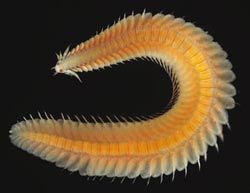Cryptic worms encountered outside Sweden

The new-found, cryptical Polychaetes Paranaitis katoi. Photographs: Arne Nygren & Fredrik Pleijel<br>
Polychaetes belong to a group of segmented worms that display enormous diversity. It turns out that there may be significantly more of these worms than researchers had imagined. Many of the worm species have been identified morphologically, that is to say on the basis of their appearance. New molecular techniques show that many worms that have been assumed to belong to the same family are not as closely related as had been thought.
Cryptic species
The research scientist Jenny Eklöf at the Department of Zoology works in the rapidly advancing field of research which studies what are known as cryptic species, that is to say animals that are identical in appearance but genetically entirely different. The focus once more is on polychaetes, where Eklöf and her colleagues show that the Scandinavian species Paranaitis wahlbergi is in fact two separate species. The researchers have named the new species, which has been encountered off Sweden, Norway and Scotland, Paranaitis katoi.
Singles species in fact two
The researchers have also found in the group of worms Notophyllum foliosum that what has been regarded as a single species is in fact two. The two species live in the same geographical area but are found at different depths: below and above the 100-metre limit. The new species is found in deep water and has been given the name Notophyllum crypticum.
Eklöf has also found a polychaete not previously encountered in European waters: Axiokebuita, a genus that usually lives in the Antarctic and also in eastern Canada.
The thesis Taxonomy and phylogeny of polychaetes was publicly defended on 21 May. Link to thesis: http://gupea.ub.gu.se/handle/2077/22179
Contact:
Jenny Eklöf, Department of Zoology, University of Gothenburg
+46 (0)31 7863661
+46 (0)763 479250
jenny.eklof@gmail.com
Media Contact
More Information:
http://gupea.ub.gu.se/handle/2077/22179All latest news from the category: Life Sciences and Chemistry
Articles and reports from the Life Sciences and chemistry area deal with applied and basic research into modern biology, chemistry and human medicine.
Valuable information can be found on a range of life sciences fields including bacteriology, biochemistry, bionics, bioinformatics, biophysics, biotechnology, genetics, geobotany, human biology, marine biology, microbiology, molecular biology, cellular biology, zoology, bioinorganic chemistry, microchemistry and environmental chemistry.
Newest articles

High-energy-density aqueous battery based on halogen multi-electron transfer
Traditional non-aqueous lithium-ion batteries have a high energy density, but their safety is compromised due to the flammable organic electrolytes they utilize. Aqueous batteries use water as the solvent for…

First-ever combined heart pump and pig kidney transplant
…gives new hope to patient with terminal illness. Surgeons at NYU Langone Health performed the first-ever combined mechanical heart pump and gene-edited pig kidney transplant surgery in a 54-year-old woman…

Biophysics: Testing how well biomarkers work
LMU researchers have developed a method to determine how reliably target proteins can be labeled using super-resolution fluorescence microscopy. Modern microscopy techniques make it possible to examine the inner workings…





















